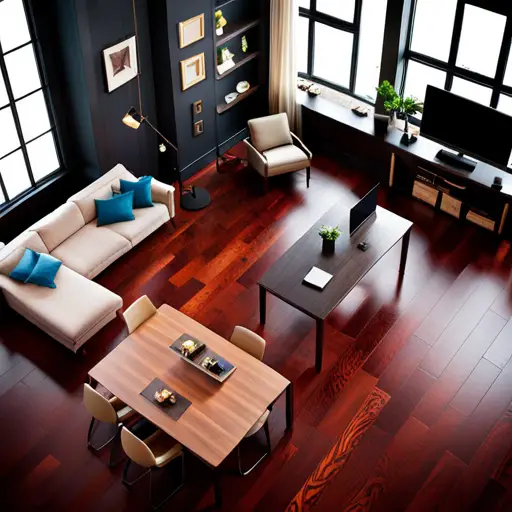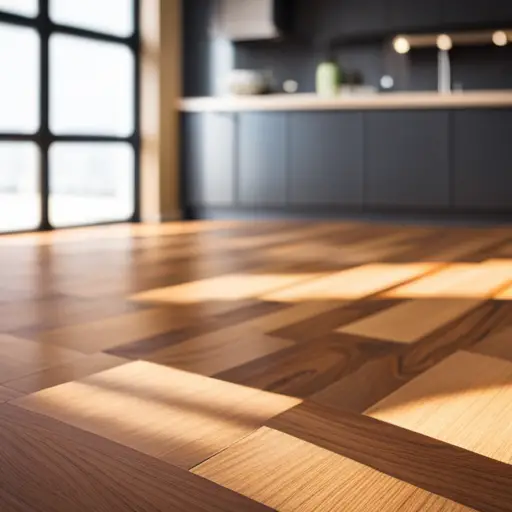Acoustic Flooring Solutions for Quiet Spaces

Coinciding with the increasing demand for peaceful and productive environments, the significance of acoustic flooring solutions cannot be overstated.
From cork to rubber, luxury vinyl to carpet tiles, each material plays a vital role in mitigating noise and enhancing comfort in various spaces.
Understanding the benefits, installation techniques, and long-term durability of these solutions is crucial for creating tranquil and efficient settings.
This article explores the diverse options and considerations for achieving quiet, serene spaces through acoustic flooring.
Importance of Acoustic Flooring
In modern architectural design, the importance of acoustic flooring has become increasingly evident over the past decade. As buildings have evolved to encompass open-plan layouts, industrial aesthetics, and mixed-use spaces, the need for effective acoustic design and noise reduction techniques has become paramount.
Acoustic flooring plays a vital role in creating comfortable and productive environments by minimizing sound transmission between floors, reducing impact noise from foot traffic, and absorbing airborne noise within a space.
Acoustic design, particularly in commercial and residential settings, requires a holistic approach that addresses not only the walls and ceilings but also the flooring. By integrating specialized materials and construction techniques, such as underlays, sound-absorbing carpets, and resilient flooring systems, architects and designers can significantly enhance the acoustic performance of a space.
This is particularly crucial in spaces where concentration, privacy, and tranquility are essential, such as offices, libraries, educational institutions, and healthcare facilities.
Types of Acoustic Flooring Materials
When selecting acoustic flooring materials, architects and designers must consider a range of options to effectively address sound transmission and impact noise within a space.
Flooring materials play a crucial role in soundproofing options, offering various solutions to create quieter environments.
Common acoustic flooring materials include cork, rubber, carpet, and vinyl.
Cork flooring, for instance, is known for its natural sound-absorbing properties, making it an excellent choice for reducing impact noise and sound transmission.
Rubber flooring, on the other hand, provides impact resistance and noise reduction, making it suitable for high-traffic areas.
Carpet, especially with dense padding, can effectively absorb sound and reduce impact noise.
Vinyl flooring, when combined with an acoustic underlayment, offers soundproofing benefits by minimizing noise transfer between floors.
Each of these materials presents unique characteristics and advantages in addressing acoustic concerns within different spaces.
Transitioning into the subsequent section about the benefits of cork flooring, it is evident that the selection of acoustic flooring materials is pivotal in achieving optimal soundproofing and creating tranquil environments.
Benefits of Cork Flooring
Cork flooring offers a range of benefits that make it an attractive option for acoustic solutions. Its eco-friendly nature provides sound insulation without harming the environment.
Additionally, cork’s natural warmth and comfort, along with its durability and low-maintenance qualities, make it a practical and sustainable choice for creating quiet spaces.
Eco-Friendly Sound Insulation
Eco-friendly sound insulation is a key benefit of utilizing cork flooring in acoustic design for quiet spaces. Cork flooring offers environmentally friendly solutions by using sustainable materials. The unique cellular structure of cork provides natural sound insulation properties, effectively reducing noise and reverberation in indoor environments. This not only creates a peaceful and quiet atmosphere but also contributes to a healthier indoor environment.
Additionally, cork is a renewable and sustainable material, making it an eco-friendly choice for sound insulation in buildings. Its production involves minimal environmental impact, and it can be harvested without causing harm to the cork oak tree. The use of cork flooring aligns with the principles of sustainable design, making it an ideal choice for eco-conscious acoustic solutions.
Transitioning into the subsequent section about ‘natural warmth and comfort’, cork flooring also provides natural thermal insulation, adding to the overall comfort of a space.
Natural Warmth and Comfort
One significant benefit of cork flooring in acoustic design for quiet spaces is its natural ability to provide warmth and comfort, contributing to a cozy and inviting atmosphere. Cork is derived from natural materials, making it an eco-friendly choice for acoustic performance. Its cellular structure traps pockets of air, providing insulation against noise and temperature fluctuations.
The unique properties of cork allow it to absorb sound, reducing impact noise and creating a peaceful environment. Furthermore, cork flooring is soft and yielding underfoot, offering a comfortable surface for prolonged standing or walking. This combination of acoustic benefits and physical comfort makes cork flooring an ideal choice for creating quiet and welcoming spaces.
Now, let’s explore the durability and low-maintenance aspects of cork flooring.
Durable and Low-Maintenance
An essential feature of cork flooring is its durability and low-maintenance, making it a practical choice for acoustic flooring solutions in quiet spaces.
Cork flooring is renowned for its ability to withstand heavy foot traffic and daily wear and tear, making it a cost-effective solution for both residential and commercial spaces. Its natural resilience to moisture and impact ensures that it maintains its quality over time, requiring minimal maintenance.
Additionally, cork flooring offers a range of innovative designs that cater to various aesthetic preferences, blending seamlessly with diverse interior styles while retaining its durability.
This combination of durability, low-maintenance, and innovative designs makes cork flooring a highly desirable option for creating quiet, comfortable, and long-lasting spaces.
Advantages of Rubber Flooring
Rubber flooring offers numerous advantages for creating quiet and comfortable spaces. Its sound absorption benefits make it an ideal choice for reducing noise in various environments.
Additionally, its durability and resilience, along with easy maintenance and cleaning, make it a practical and long-lasting option for acoustic flooring solutions.
Sound Absorption Benefits
Discussing the sound absorption benefits of rubber flooring enhances the acoustic properties of a space, contributing to a quieter and more peaceful environment. Rubber flooring is a soundproofing technique that effectively absorbs impact noise and reduces airborne sound transmission. Its ability to dampen noise makes it an ideal choice for spaces where acoustic design principles are crucial, such as offices, libraries, and educational institutions.
Durable and Resilient
The exceptional durability and resilience of rubber flooring make it a highly sought-after acoustic flooring solution for a wide range of commercial and institutional environments. Rubber flooring is known for its resilient performance, making it ideal for high-traffic areas. It can withstand heavy footfall, furniture movement, and other sources of wear and tear, ensuring longevity and cost-effectiveness. Additionally, rubber flooring is composed of acoustically sound materials that dampen impact noise and reduce sound transmission, contributing to a quieter and more peaceful environment. Here is a table illustrating the advantages of rubber flooring:
| Advantages of Rubber Flooring | ||
|---|---|---|
| Exceptional Durability | Resilient Performance | Acoustic Soundness |
| Longevity | Cost-effectiveness | Impact Noise Reduction |
| High-Traffic Suitability | Low Maintenance | Sound Transmission Reduction |
| Wear and Tear Resistance |
Easy Maintenance and Cleaning
Maintenance and cleaning of rubber flooring is straightforward, requiring minimal effort and resources to uphold its longevity and performance in high-traffic areas. The advantages of rubber flooring in terms of efficient cleaning and long-lasting care are evident:
-
Easy to Clean: Rubber flooring can be easily cleaned with a mild detergent and water, requiring minimal time and effort for maintenance.
-
Stain Resistant: Its non-porous surface makes rubber flooring resistant to stains, allowing for quick and hassle-free cleanup of spills and messes.
-
Durable Finish: The durable finish of rubber flooring ensures that it can withstand frequent cleaning without deteriorating, making it a cost-effective and low-maintenance option for quiet spaces.
With its ability to maintain its quality with efficient cleaning and long-lasting care, rubber flooring is an ideal choice for spaces where ease of maintenance is a priority.
Considerations for Luxury Vinyl
How can luxury vinyl flooring contribute to creating a quieter and more peaceful environment in interior spaces?
Luxury vinyl flooring offers a range of soundproofing techniques that can significantly reduce noise transmission and impact sound. The construction of luxury vinyl includes layers designed to absorb and dampen sound, providing enhanced acoustical performance. Additionally, underlayment materials can be added to further improve sound insulation, making luxury vinyl an effective choice for minimizing noise in various settings, from residential to commercial environments.
Luxury vinyl’s soundproofing capabilities make it an ideal option for creating tranquil spaces in offices, hotels, educational institutions, and residential homes. Its ability to reduce impact sound and minimize the transmission of noise between floors can greatly enhance the comfort and privacy of occupants. Furthermore, luxury vinyl’s durability and low maintenance requirements make it a practical and long-lasting solution for achieving acoustic comfort in interior spaces.
Transitioning into the impact of carpet tiles, it’s important to consider how different flooring materials can influence the overall acoustic performance of a space.
Impact of Carpet Tiles
When considering the impact of carpet tiles on acoustic performance in interior spaces, it is important to evaluate their ability to minimize noise transmission and enhance sound insulation. Carpet tiles offer several benefits that contribute to noise reduction techniques and create quieter environments:
-
Sound Absorption: Carpet tiles are effective at absorbing sound, reducing the level of noise in a room and preventing it from bouncing off hard surfaces. This results in a quieter and more comfortable space for occupants.
-
Impact Noise Reduction: The use of carpet tiles helps to minimize impact noise, such as footsteps, which can be a common source of disturbance in commercial and residential settings. This is particularly advantageous in multi-story buildings where impact noise can easily travel between floors.
-
Improved Acoustic Comfort: The soft and cushioned nature of carpet tiles provides a more pleasant and comfortable acoustic environment, reducing the harshness of sound and creating a more inviting space for individuals.
Incorporating carpet tiles into interior spaces not only enhances the aesthetic appeal but also plays a significant role in creating quiet and peaceful environments through effective noise reduction techniques.
Installation Techniques for Noise Reduction
To achieve effective noise reduction in interior spaces, incorporating carpet tiles with proper installation techniques is essential for maximizing acoustic performance. Effective installation techniques play a crucial role in enhancing the overall acoustics in construction and architectural design. One such technique is the use of acoustic underlayment, which acts as a sound barrier and helps reduce impact noise transmission. Additionally, the use of double bonding installation method, where the carpet tiles are affixed to both the floor and each other, further enhances noise reduction capabilities.
The table below outlines some key installation techniques for noise reduction:
| Installation Technique | Description |
|---|---|
| Acoustic Underlayment | Reduces impact noise transmission |
| Double Bonding Method | Enhances noise reduction capabilities |
| Proper Seam Sealing | Prevents sound leakage through tile connections |
| Strategic Placement of Tiles | Optimizes sound absorption and noise reduction |
Maintenance and Long-Term Durability
For the maintenance and long-term durability of acoustic flooring solutions, regular inspection and cleaning are imperative. Proper care and maintenance not only ensure the longevity of the flooring but also contribute to sustained noise reduction capabilities.
To ensure the long-term effectiveness of acoustic flooring solutions, consider the following maintenance practices:
-
Regular Inspection: Schedule routine inspections to identify any signs of wear and tear, such as cracks, gaps, or lifting of the flooring material. Promptly addressing these issues can prevent further damage and maintain the flooring’s noise reduction properties.
-
Cleaning Regimen: Establish a consistent cleaning schedule using appropriate methods and products recommended by the flooring manufacturer. Regular cleaning removes dirt, debris, and potential sound-absorbing obstructions, thus preserving the flooring’s acoustic performance.
-
Periodic Maintenance: Engage in periodic maintenance activities, such as resealing or refinishing, as recommended by the manufacturer. This helps uphold the structural integrity of the flooring and sustains its noise reduction capabilities over time.
Frequently Asked Questions
Can Acoustic Flooring Solutions Also Help With Soundproofing Walls and Ceilings in Addition to Floors?
Acoustic flooring solutions can also be effective in soundproofing walls and ceilings. Utilizing acoustic wall treatments and soundproofing techniques, alongside ceiling acoustic panels and insulation, creates a comprehensive approach to reducing noise and creating quiet spaces.
Are There Any Eco-Friendly Acoustic Flooring Options Available for Those Looking for Sustainable Materials?
Eco-friendly acoustic flooring options are available for those seeking sustainable materials. These solutions prioritize eco-friendly materials and sustainable options, offering an installation process that aligns with green initiatives and maintenance requirements that support long-term environmental stewardship.
What Are the Potential Cost Savings Associated With Installing Acoustic Flooring in Terms of Energy Efficiency and Reduced Noise-Related Health Issues?
Potential cost savings associated with installing acoustic flooring include improved energy efficiency due to better insulation and reduced noise-related health issues, leading to lower healthcare costs. These benefits make acoustic flooring a sound investment in creating healthier, more sustainable spaces.
How Do Acoustic Flooring Solutions Compare in Terms of Fire Safety and Resistance to Water Damage?
When considering fire safety and water resistance, acoustic flooring solutions are paramount. These solutions offer high fire safety ratings and exceptional water resistance, ensuring a safe and resilient environment. Moreover, they bring cost benefits and a positive environmental impact.
Are There Any Specific Recommendations for Acoustic Flooring in Commercial Spaces, Such as Offices or Healthcare Facilities, to Address Specific Noise Concerns?
When addressing noise concerns in commercial spaces like offices or healthcare facilities, acoustic flooring plays a crucial role. Properly selected and installed acoustic flooring can significantly reduce noise, contributing to improved workplace productivity and enhanced patient well-being in healthcare environments.
Conclusion
In conclusion, acoustic flooring solutions play a crucial role in creating quiet and peaceful spaces.
Cork flooring, rubber flooring, luxury vinyl, and carpet tiles are effective materials for noise reduction.
Proper installation techniques and regular maintenance contribute to the long-term durability of acoustic flooring.
Investigating the truth of these theories allows for the creation of a tranquil and serene environment, enhancing the overall experience within a space.

Rubin Everest, a seasoned expert in the world of flooring, brings a wealth of knowledge and passion to the surface. As the mind behind ebbow.com, Rubin is dedicated to sharing insights on the latest trends, innovative solutions, and expert advice in the realm of flooring. Whether you’re seeking practical tips for installation or design inspiration, Rubin Everest is your go-to source for all things flooring-related, making your journey to the perfect floor an informed and enjoyable experience.





